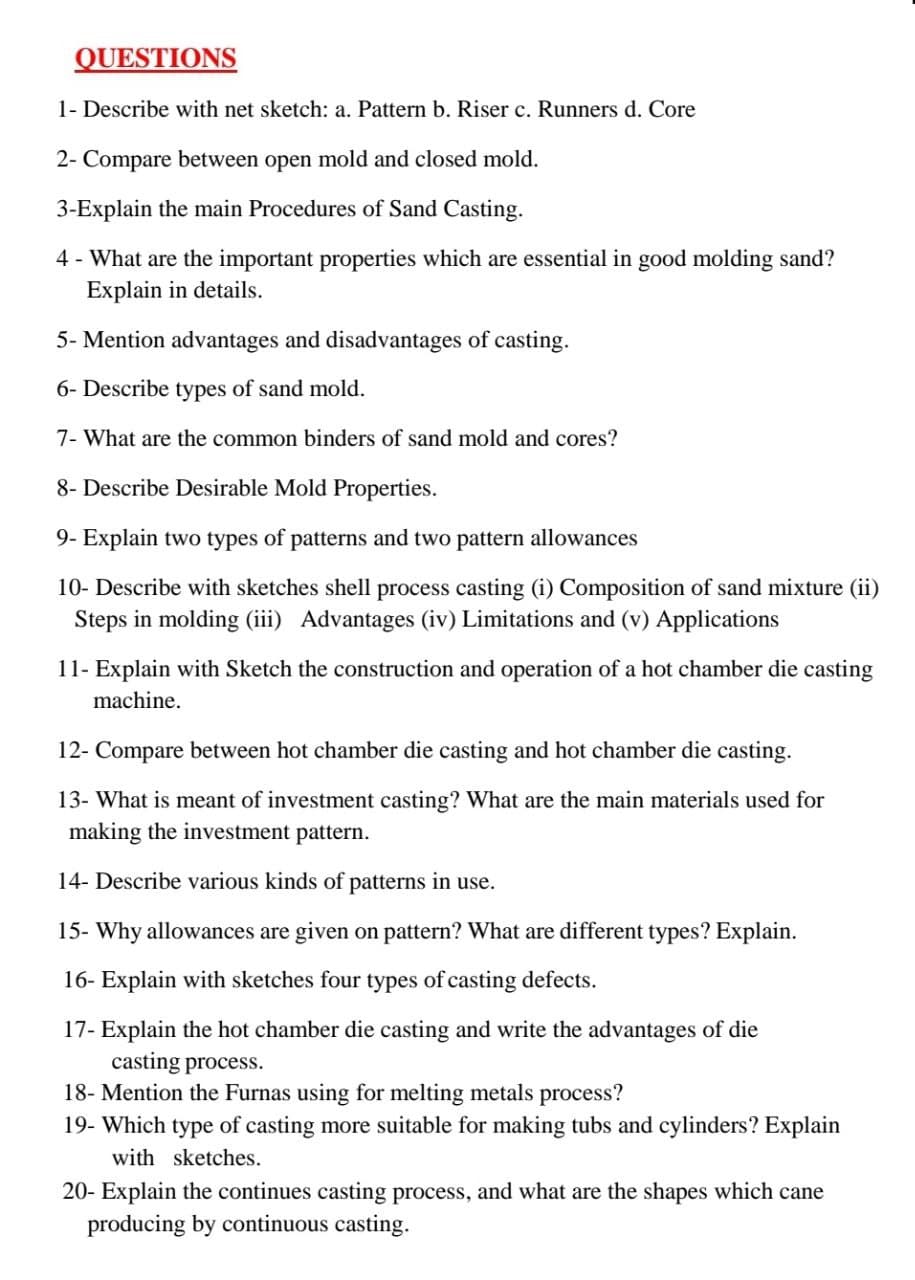QUESTIONS 1- Describe with net sketch: a. Pattern b. Riser c. Runners d. Core 2- Compare between open mold and closed mold. 3-Explain the main Procedures of Sand Casting. 4 - What are the important properties which are essential in good molding sand? Explain in details. 5- Mention advantages and disadvantages of casting. 6- Describe types of sand mold. 7- What are the common binders of sand mold and cores? 8- Describe Desirable Mold Properties. 9- Explain two types of patterns and two pattern allowances 10- Describe with sketches shell process casting (i) Composition of sand mixture (ii) Steps in molding (iii) Advantages (iv) Limitations and (v) Applications 11- Explain with Sketch the construction and operation of a hot chamber die casting machine. 12- Compare between hot chamber die casting and hot chamber die casting. 13- What is meant of investment casting? What are the main materials used for making the investment pattern. 14- Describe various kinds of patterns in use. 15- Why allowances are given on pattern? What are different types? Explain. 16- Explain with sketches four types of casting defects. 17- Explain the hot chamber die casting and write the advantages of die casting process. 18- Mention the Furnas using for melting metals process? 19- Which type of casting more suitable for making tubs and cylinders? Explain with sketches. 20- Explain the continues casting process, and what are the shapes which cane producing by continuous casting.
QUESTIONS 1- Describe with net sketch: a. Pattern b. Riser c. Runners d. Core 2- Compare between open mold and closed mold. 3-Explain the main Procedures of Sand Casting. 4 - What are the important properties which are essential in good molding sand? Explain in details. 5- Mention advantages and disadvantages of casting. 6- Describe types of sand mold. 7- What are the common binders of sand mold and cores? 8- Describe Desirable Mold Properties. 9- Explain two types of patterns and two pattern allowances 10- Describe with sketches shell process casting (i) Composition of sand mixture (ii) Steps in molding (iii) Advantages (iv) Limitations and (v) Applications 11- Explain with Sketch the construction and operation of a hot chamber die casting machine. 12- Compare between hot chamber die casting and hot chamber die casting. 13- What is meant of investment casting? What are the main materials used for making the investment pattern. 14- Describe various kinds of patterns in use. 15- Why allowances are given on pattern? What are different types? Explain. 16- Explain with sketches four types of casting defects. 17- Explain the hot chamber die casting and write the advantages of die casting process. 18- Mention the Furnas using for melting metals process? 19- Which type of casting more suitable for making tubs and cylinders? Explain with sketches. 20- Explain the continues casting process, and what are the shapes which cane producing by continuous casting.
Elements Of Electromagnetics
7th Edition
ISBN:9780190698614
Author:Sadiku, Matthew N. O.
Publisher:Sadiku, Matthew N. O.
ChapterMA: Math Assessment
Section: Chapter Questions
Problem 1.1MA
Related questions
Question

Transcribed Image Text:QUESTIONS
1- Describe with net sketch: a. Pattern b. Riser c. Runners d. Core
2- Compare between open mold and closed mold.
3-Explain the main Procedures of Sand Casting.
4 - What are the important properties which are essential in good molding sand?
Explain in details.
5- Mention advantages and disadvantages of casting.
6- Describe types of sand mold.
7- What are the common binders of sand mold and cores?
8- Describe Desirable Mold Properties.
9- Explain two types of patterns and two pattern allowances
10- Describe with sketches shell process casting (i) Composition of sand mixture (ii)
Steps in molding (iii) Advantages (iv) Limitations and (v) Applications
11- Explain with Sketch the construction and operation of a hot chamber die casting
machine.
12- Compare between hot chamber die casting and hot chamber die casting.
13- What is meant of investment casting? What are the main materials used for
making the investment pattern.
14- Describe various kinds of patterns in use.
15- Why allowances are given on pattern? What are different types? Explain.
16- Explain with sketches four types of casting defects.
17- Explain the hot chamber die casting and write the advantages of die
casting process.
18- Mention the Furnas using for melting metals process?
19- Which type of casting more suitable for making tubs and cylinders? Explain
with sketches.
20- Explain the continues casting process, and what are the shapes which cane
producing by continuous casting.
Expert Solution
This question has been solved!
Explore an expertly crafted, step-by-step solution for a thorough understanding of key concepts.
This is a popular solution!
Trending now
This is a popular solution!
Step by step
Solved in 3 steps with 3 images

Knowledge Booster
Learn more about
Need a deep-dive on the concept behind this application? Look no further. Learn more about this topic, mechanical-engineering and related others by exploring similar questions and additional content below.Recommended textbooks for you

Elements Of Electromagnetics
Mechanical Engineering
ISBN:
9780190698614
Author:
Sadiku, Matthew N. O.
Publisher:
Oxford University Press

Mechanics of Materials (10th Edition)
Mechanical Engineering
ISBN:
9780134319650
Author:
Russell C. Hibbeler
Publisher:
PEARSON

Thermodynamics: An Engineering Approach
Mechanical Engineering
ISBN:
9781259822674
Author:
Yunus A. Cengel Dr., Michael A. Boles
Publisher:
McGraw-Hill Education

Elements Of Electromagnetics
Mechanical Engineering
ISBN:
9780190698614
Author:
Sadiku, Matthew N. O.
Publisher:
Oxford University Press

Mechanics of Materials (10th Edition)
Mechanical Engineering
ISBN:
9780134319650
Author:
Russell C. Hibbeler
Publisher:
PEARSON

Thermodynamics: An Engineering Approach
Mechanical Engineering
ISBN:
9781259822674
Author:
Yunus A. Cengel Dr., Michael A. Boles
Publisher:
McGraw-Hill Education

Control Systems Engineering
Mechanical Engineering
ISBN:
9781118170519
Author:
Norman S. Nise
Publisher:
WILEY

Mechanics of Materials (MindTap Course List)
Mechanical Engineering
ISBN:
9781337093347
Author:
Barry J. Goodno, James M. Gere
Publisher:
Cengage Learning

Engineering Mechanics: Statics
Mechanical Engineering
ISBN:
9781118807330
Author:
James L. Meriam, L. G. Kraige, J. N. Bolton
Publisher:
WILEY